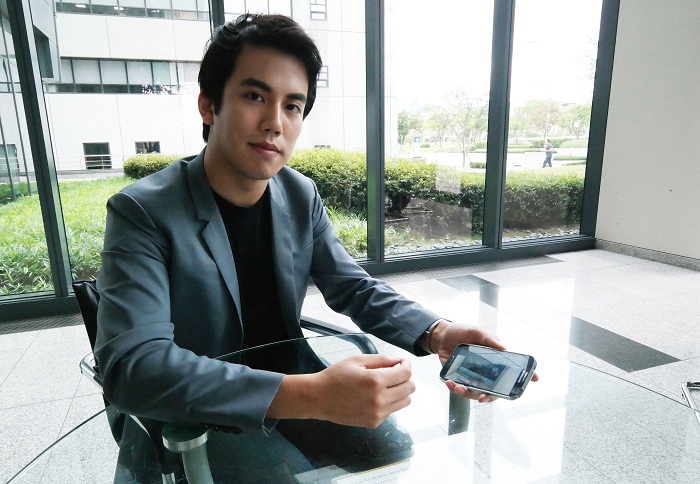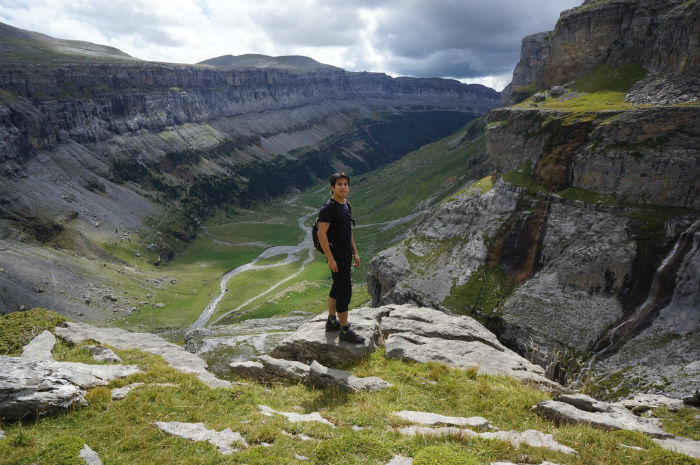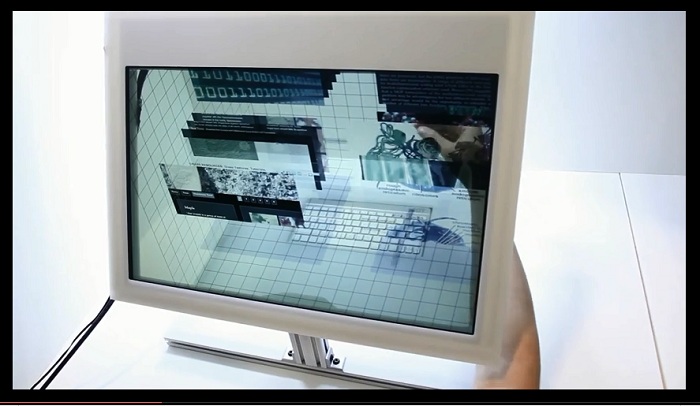In a scene from any one of the Iron Man movies, the hero uses the space in front of him as a "screen" or "computer monitor," pulling up videos into the air and controlling the content with his bare hands. In this limitless and boundless area of air, plenty of data and a wide range of information can come into sight at once. This magical moment, once considered possible only far in the future, is now coming closer to reality.

Engineer Lee Jinha, director of the Interactive Visualization Lab at Samsung Electronics, has garnered a lot of global attention with his recent innovations that could tear down the boundary between the physical and digital worlds, just as in the Iron Man movies. At the core is the so-called SpaceTop technology. It allows computer-users to manage their content and files inside the screen. He began to attract attention in February last year when he gave a demonstration of the new technology in a TED Talk at the Future of Touch & Interactivity Conference. In recognition of his innovative contributions to communication tools, he was recently selected as a "TR35," one of the MIT Technology Review's list of 35 innovators under the age of 35.
Along with SpaceTop, Lee also works on the ZeroN project. It is a levitating 3-D ball that can move freely by computer in a three dimensional space.
When asked about what's behind these creative ideas, he replied that he, "Enjoys reading and exploring the world of mythology."
Korea.net interviewed Lee to delve deeper into his imagination and to hear more about the future of which he dreams.
Communication has become an important core value of our society these days. You have expanded the scope of communication that previously only happened between humans. Now, humans can interact with objects. What's the source of your imagination?
Nowadays, we face a lot of serious problems. I believe that if we can manage to properly use digital technologies and data, we have plenty of potential to solve those problems. We can become a wiser species. Today, we use only a little part of our available potential because there are few channels that allow for interaction between the physical and digital world. I wanted to see if there were any feasible ways for digital information and data to be implemented in real life.
It has probably been hard to satiate your strong curiosity. You may have had less of a chance to use your imagination in Korea's strict and exam-oriented education system. What has helped you to become so free?
I was in Korea until my high school years. I wasn't that different from the other classmates.
I spent my university years in Japan, during which I lived in Mitaka in Tokyo, a very remote region. I had to walk at least 40 minutes to get to the closest subway station. That gave me plenty of time to think. I thought a lot about how I would be able to manage my life and adapt myself to an unfamiliar environment. I suppose that has helped me a lot.
I go for regular trips alone, to feel and to be free. I love places where I can bump into wild life. Standing at the boundary between freedom and non-freedom instills in me new ideas.

Human history has gone through a series of breakdowns of the monopoly of knowledge. For instance, our knowledge allowed for only limited intellectuals during the Middle Ages, but it became widely available later with the revolution in printing. In a capitalistic society, however, the sharing of knowledge for free is likely to face resistance from those with vested interests. How do you think you would overcome it?
In the era of "networking," the value of goods can be created in an ecology in which knowledge is interacted with, not necessarily through the knowledge itself.
There is a growing number of people who benefit from free sharing. They appear to have the power to create more resources and values. We are gradually becoming aware that both resources and the planet's self-purification capacity have limits. The current generation has many complicated problems to solve within the not-too-distant future. We will have to resort to humanity's collective intelligence and at the center of that is the sharing and accumulation of information. However, policies and regulations seem unable to follow that flow. In my eyes, it can still have a positive influence, as it can enable people to have some time to get accustomed to the change.
You get research ideas and inspiration from mythology. What is it among the many stories that has attracted you?
I don't think I was inspired by any particular legend.
Instead, I was given an idea when I discovered that common elements exist in stories from different cultures. For instance, there are stories about the desire to manipulate objects, both in Hermetic art and in the golem legends. It seemed to me that humanity's fear of the limits of life are presented in a diverse range of ways. It finally inspired in me the idea to experiment with a technology that enables us to manage real objects, the way we deal with graphics and images in our digital world. That became the basis for my ZeroN project.
Your SpaceTop technology seems interesting in that it succeeded in tearing down the boundary between the physical and digital worlds. It might not have been easy to come up with your results. What was the biggest challenge and how did you overcome it?
SpaceTop is an experimental prototype that enables us to test the potential and vision of an idea, but only if we can send the information stuck on our desktop screens into a three dimensional space and manage them all together. I have also had difficulties in that researchers usually go through almost every design or engineering project. From now on, we will face more difficult tasks.

I still have a long way to go, until I can use the technology in real life. I have plenty of things yet to be done, from optical techniques and sensors through to delays between displays.
What does your dream world look like? How do you want to change the world?
I hope humanity can be wiser, wise enough to be in harmony with the nature that surrounds us. We need to carefully look back and think about the consequences of our behavior.
By Lee Seung-ah
Korea.net Staff Writer
slee27@korea.kr

Engineer Lee Jinha has revealed his new SpaceTop technology that breaks the boundary that existed between the physical and digital worlds.
Engineer Lee Jinha, director of the Interactive Visualization Lab at Samsung Electronics, has garnered a lot of global attention with his recent innovations that could tear down the boundary between the physical and digital worlds, just as in the Iron Man movies. At the core is the so-called SpaceTop technology. It allows computer-users to manage their content and files inside the screen. He began to attract attention in February last year when he gave a demonstration of the new technology in a TED Talk at the Future of Touch & Interactivity Conference. In recognition of his innovative contributions to communication tools, he was recently selected as a "TR35," one of the MIT Technology Review's list of 35 innovators under the age of 35.
Along with SpaceTop, Lee also works on the ZeroN project. It is a levitating 3-D ball that can move freely by computer in a three dimensional space.
When asked about what's behind these creative ideas, he replied that he, "Enjoys reading and exploring the world of mythology."
Korea.net interviewed Lee to delve deeper into his imagination and to hear more about the future of which he dreams.
Communication has become an important core value of our society these days. You have expanded the scope of communication that previously only happened between humans. Now, humans can interact with objects. What's the source of your imagination?
Nowadays, we face a lot of serious problems. I believe that if we can manage to properly use digital technologies and data, we have plenty of potential to solve those problems. We can become a wiser species. Today, we use only a little part of our available potential because there are few channels that allow for interaction between the physical and digital world. I wanted to see if there were any feasible ways for digital information and data to be implemented in real life.
It has probably been hard to satiate your strong curiosity. You may have had less of a chance to use your imagination in Korea's strict and exam-oriented education system. What has helped you to become so free?
I was in Korea until my high school years. I wasn't that different from the other classmates.
I spent my university years in Japan, during which I lived in Mitaka in Tokyo, a very remote region. I had to walk at least 40 minutes to get to the closest subway station. That gave me plenty of time to think. I thought a lot about how I would be able to manage my life and adapt myself to an unfamiliar environment. I suppose that has helped me a lot.
I go for regular trips alone, to feel and to be free. I love places where I can bump into wild life. Standing at the boundary between freedom and non-freedom instills in me new ideas.

Lee enjoys trips alone, to feel and to be free.
Human history has gone through a series of breakdowns of the monopoly of knowledge. For instance, our knowledge allowed for only limited intellectuals during the Middle Ages, but it became widely available later with the revolution in printing. In a capitalistic society, however, the sharing of knowledge for free is likely to face resistance from those with vested interests. How do you think you would overcome it?
In the era of "networking," the value of goods can be created in an ecology in which knowledge is interacted with, not necessarily through the knowledge itself.
There is a growing number of people who benefit from free sharing. They appear to have the power to create more resources and values. We are gradually becoming aware that both resources and the planet's self-purification capacity have limits. The current generation has many complicated problems to solve within the not-too-distant future. We will have to resort to humanity's collective intelligence and at the center of that is the sharing and accumulation of information. However, policies and regulations seem unable to follow that flow. In my eyes, it can still have a positive influence, as it can enable people to have some time to get accustomed to the change.
You get research ideas and inspiration from mythology. What is it among the many stories that has attracted you?
I don't think I was inspired by any particular legend.
Instead, I was given an idea when I discovered that common elements exist in stories from different cultures. For instance, there are stories about the desire to manipulate objects, both in Hermetic art and in the golem legends. It seemed to me that humanity's fear of the limits of life are presented in a diverse range of ways. It finally inspired in me the idea to experiment with a technology that enables us to manage real objects, the way we deal with graphics and images in our digital world. That became the basis for my ZeroN project.
Your SpaceTop technology seems interesting in that it succeeded in tearing down the boundary between the physical and digital worlds. It might not have been easy to come up with your results. What was the biggest challenge and how did you overcome it?
SpaceTop is an experimental prototype that enables us to test the potential and vision of an idea, but only if we can send the information stuck on our desktop screens into a three dimensional space and manage them all together. I have also had difficulties in that researchers usually go through almost every design or engineering project. From now on, we will face more difficult tasks.

Bare hands can reach into and touch the content on the screen.
I still have a long way to go, until I can use the technology in real life. I have plenty of things yet to be done, from optical techniques and sensors through to delays between displays.
What does your dream world look like? How do you want to change the world?
I hope humanity can be wiser, wise enough to be in harmony with the nature that surrounds us. We need to carefully look back and think about the consequences of our behavior.
By Lee Seung-ah
Korea.net Staff Writer
slee27@korea.kr